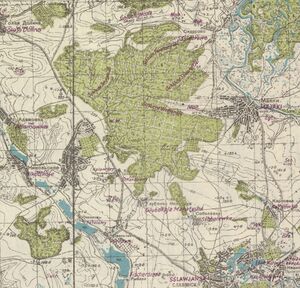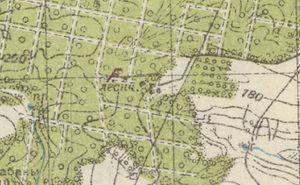29. April 1942
| GEO & MIL INFO | ||||
|---|---|---|---|---|
| Forester’s Lodge | ||||
| OKW-Lagekarte Mai 1942 | ||||
| as leader of the heavy weapons attached to 1st Company[1] | ||||


It is the end of April. The air is warm and dry. The village has come alive again after the winter dormancy. The women and girls are digging and hoeing in the gardens. Our Landser are helping diligently in places. In some cases they have used our teams to plough. The black soil is damp and heavy from the wetness of the melting snow, but day after day the sun sends down its warm rays and a strong earthy smell emanates from the dark soil. After only a few days, the first green sprouts and grows with surprising speed. It literally shoots out of the ground. Spring comes very late in Russia, but it is short and quickly turns into summer. Now the warming rays of the sun cause the moisture-saturated soil to burst forth, germinate and grow with vitality. You can truly see the grass grow. But the “grass” is mostly grain.
I sit on the bench in front of the house. The evening is warm and magically mild. Every now and then a gentle breeze passes over my face. The sun has already disappeared behind the hillside, but its light still illuminates the sky in bright blue and greenish pastel colours. Curling smoke rises peacefully from the chimneys into the wide, high sky. Melancholy melodies waft to me from the village well. It is girls singing there. Their full, throaty nature voices also resonate with the dawning spring.
The front is relatively quiet. Only from time to time does a Ratsch-Bum[4] shoot into the village. It doesn't bother us much, but at least it has already set fire to a few farmhouses, the ruins of which are a reminder that it's war in the midst of nature’s peaceful awakening. The only things that mostly remain standing in the ruins are the chimneys, raised like warning fingers.
Only from the forester’s lodge does the noise of battle resound again and again. It lies to the left[5] of us on the heights at the edge of the forest and is a focal point of the fighting. There are still three bunker positions between Majaki and the forester’s lodge.
Apart from Max Müller, I met another old acquaintance here: Franz Bachem. He has been removed from the list of officer candidates and will therefore remain a sergeant. This does not seem to have caused the fun-loving Rhinelander much grief. He is as chipper as ever, or at least pretends to be. He has also - since Kombornia - always remained with the 4th Company, while I was transferred to Jasło back then.
I am commanded to the forester’s lodge.[6] It is situated on the edge of the large Christishche Forest, which surrounds it on three sides. Actually it must have been a collective farm, for several buildings belong to it. Except for the barn with mud walls and thatched roof, all the other buildings are already in ruins. But there are strong bunkers under the ruins. The whole complex, about 100 x 100 m square, has been developed into a strong base, has a crew of 120, several heavy MGs, grenade launchers and three 3.7-cm Paks. The forester’s lodge lies like a blocking fort on the road leading to Slavyansk via Karpovka. It is therefore a thorn in the side of the Soviets and is repeatedly shelled and attacked by shock troops. Since the Russians control the forest, which reaches as far as the forester’s lodge on three sides, they can get right up to our positions almost unnoticed. The danger of surprise raids constantly hangs over the base like a Sword of Damocles and requires complete and fierce vigilance. That costs nerves, and the forester’s lodge has a bad reputation among the landsers.
Now, as the leader of the heavy weapons, I sit with the base commander in the command post of the forester’s lodge. The commander is a young, dashing second lieutenant by the name of Schröder, only a little nervous. His deputy, also a second lieutenant, is a fitting balance with his calm nature. Both are easy to get along with. The three of us live in a bunker under the shot-up main building. The fourth man should actually be the messenger, an older man, who lives with us, but because of the many breakdowns and the need for increased vigilance, he is often assigned to guard duty and is rarely present. To provide some relief for the overworked men, I volunteer to take over a night watch now and then.
Now I have taken over another watch. I stand in an earth bunker at the edge of the forest and look through the embrasure across the deforested apron. It is dark night. I can only vaguely see the stubs and sawed-off tree stumps like lumps on the ground. From time to time, the moon emerges from the clouds and illuminates the terrain a little. But the shadows of the tree stumps make the uneven ground even more confusing, is that a tree stump there at all? Hasn’t it just moved? Or has just a cloud shadow flitted over it? Was there ever a stump there? What did the spot actually look like by day? The imagination sees a creeping Russian in every tree stump. I strain my hearing. There is nothing suspicious to be heard. I bore my eyes into the darkness. The stumps remain motionless. Slowly the tension gives way to normal alertness until the replacement arrives.
A few days later, a shot rings out near the same bunker. It is followed by the cry of a wounded man. Allegedly, a Soviet flamethrower squad crept up between the tree stumps. There is nothing to be seen now, but the wounded man is still screaming. He screams in long drawn-out tones, interrupted by halting moans and groans. Hour after hour. His comrades no longer dare to go into the clearing. And neither do we. So he screams all night. From time to time he falls silent. Then he wails again. But the silent pauses grow longer and longer. His stretched shouting quieter and quieter. Still, his wailing continues to echo through the night, until morning. When it becomes lighter, he has fallen silent.
A Ratsch-Bum is adjusted directly at our bunker. It fires at irregular intervals, and only one shot at a time.
This gun is an excellent design. Calibre 7.62 cm. Very mobile, with a fast firing sequence and tremendous muzzle velocity. Firing and impact follow in fractions of a second: Ratsch-Bum! You can’t take cover. For us, a disgusting thing. As soon as I arrive, I see the three-metre-long impact rut on the path and know.[7] These days a signalsman was hit by a shell right next to our bunker while he was trying to mend a wire.
|
Editorial 1938 1939 1940 1941 1942 1943 1944 1945 1946 1947 1948 1949 Epilog Anhang |
|
January February March April May June July August September October November December Eine Art Bilanz Gedankensplitter und Betrachtungen Personen Orte Abkürzungen Stichwort-Index Organigramme Literatur Galerie:Fotos,Karten,Dokumente |
|
1. 2. 3. 4. 5. 6. 7. 8. 9. 10. 11. 12. 13. 14. 15. 16. 17. 18. 19. 20. 21. 22. 23. 24. 25. 26. 27. 28. 29. 30. 31. Erfahrungen i.d.Gefangenschaft Bemerkungen z.russ.Mentalität Träume i.d.Gefangenschaft Personen-Index Namen,Anschriften Personal I.R.477 1940–44 Übersichtskarte (Orte,Wege) Orts-Index Vormarsch-Weg Codenamen der Operationen im Sommer 1942 Mil.Rangordnung 257.Inf.Div. MG-Komp.eines Inf.Batl. Kgf.-Lagerorganisation Kriegstagebücher Allgemeines Zu einzelnen Zeitabschnitten Linkliste Rotkreuzkarte Originalmanuskript Briefe von Kompanie-Angehörigen |
- ↑ acc. to plan dated 12 May1942, KTB 257. I.D., NARA T-315 Roll 1805 Frame 000950
- ↑ Clip from Truppenausgabe Russland 1:100.000 Zusammendruck M-37 111-112
- ↑ KTB 257. I.D., NARA T-315 Roll 1805 Frame 000878
- ↑ pronounced Rach-Boom, an onomatopoetic German nickname, cf. Whizz Bang
- ↑ in the original erroneously “right”
- ↑ probably on 29.04. with the withdrawal of I./I.R. 477 from Majaki (Frame 000850/71), possibly as early as 15 or 16 Apr in the course of major regroupings (KTB 257th I.D., NARA T-315 Roll 1805 Frame 000785)
- ↑ On 13.04. there had been an attack with a tank and a Pak on the forester’s lodge (KTB 257. I.D., NARA T-315 Roll 1805 Frame 000778). The field gun Ratsch-Bum often found use as a pak. If this was a trace of it, the author would have been ordered onto the forester’s lodge shortly afterwards, while the trace was still visible, which rather argues for the date of 15 or 16 Apr, as assumed above.


